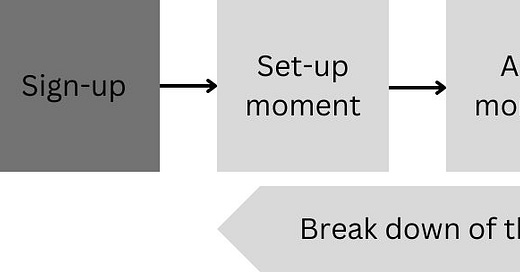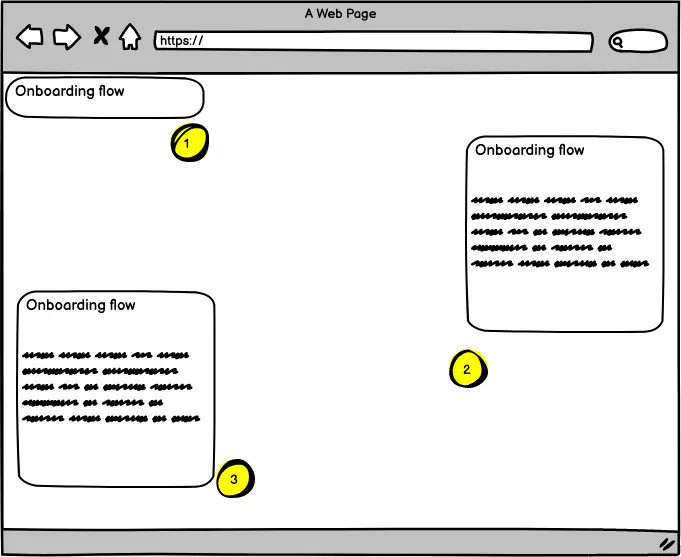Users activation, what is it?
While the most solid growth team know the value of users activation, for many it's an unknown concept. Let's dissect it.
For Product-Led Growth companies, activation plays an essential part in product success.
Let’s first define what activation is.
It’s bringing new users signups to build a habit around the core value proposition. It’s not only about showing to users the product value. You can offer users the product value, but it isn't significant if they don’t return. What is crucial is to convince users to return and use the product regularly.
So it’s essential to break down the user activation into three steps: set up moment, aha moment, and habit moment.
The setup moment
The first thing users do after creating an account is to set up their account. Whatever the app, they need to configure it. It helps to get the core value of the product. It’s not a funny step but a needed one. Let’s say you want to go for a ride. You need to wear your bib, your helmet, etc.
Those are the necessary steps to enjoy your ride. It’s the same when you sign up for a product.
Zapier: Users must configure a Zap by connecting one or many apps.
Strava: Users must connect third-party to publish data to Strava. Users must add friends to see a valuable feed.
The setup moment isn’t funny. That’s why it’s crucial to create a seamless user journey.
The aha moment
It happens after the setup moment. Users go through the aha moment when they get the product value. So, if I continue my analogy with riding a bike, during or after the ride, you feel great. It’s the aha moment.
It happens that some companies consider the setup moment to be the aha moment. It’s two different things. Remember when Facebook said the aha moment was new users getting seven friends in ten days? It’s not the aha moment, it’s the setup moment.
Zapier: Users notice the time saved thanks to the automation implemented.
Strava: Users start receiving kudos and comments about their sports session. Users can get an update on their friends’ sports sessions. They can also comment and give kudos.
It’s crucial to have the ability to measure the aha moment from quantitative data. Be careful not to measure it through fluffy metrics (logging in to an app isn’t enough, for example). It should be an action taken by users.
The habit moment
While users going through the aha moment is excellent, it doesn’t mean they will keep using your product. That’s why forming a habit moment around the product value is crucial. It means users receive enough value from the product. Then they continue using it to receive the value repeatedly.
This repeated behavior should have a weekly, monthly, or daily frequency. For my ride example, it means doing a ride once or twice per week.
Zapier: Building many zaps to save more and more time. Debugging zaps to make them work correctly.
Strava: Connecting to Strava to get news about friends’ sports sessions. Getting kudos and comments from friends
Forming the habit moment is crucial. It will help reinforce retention and monetize users over the long term.
That’s why user activation is essential. It’s a pivotal component to ensure company success.
Activation is about education and guiding users to the product value.
What’s wrong with activation?
Many growth teams don’t understand activation. Then, they prefer to focus on different areas like acquisition and retention. If working on acquisition is an excellent idea, not activating users is damageful. Indeed, money spent not being able to deliver value to users isn’t a good idea. Remember that all new signups need to go through activation. That’s why it’s crucial to work on it.
And it’s far harder to reactivate users if you fail to activate them. They will forget you. And even the best email campaign won’t reactivate most non-activated users.
When teams work on activation, they think they must invest in a product tour. And users will magically activate. Or they remove all the frictions, even the onboarding questions.
From my point of view, onboarding questions are crucial. Some people will drop off, but that's no problem. It means they have a low intent for your product. Others will answer. Those questions will help you shape a better user journey and understand their goal better. Also, all those answers will help you better understand what’s working well (or not).
Activation is the best lever to increase your revenue
As I said, activation helps to retain and make users pay. But unfortunately, many teams don’t work enough on activation. In this section, backed by data, I will show you that improving activation has a higher impact than acquisition.
Every company wants to impact its revenue. At their core, the growth team focuses on increasing revenue. Unfortunately, many growth teams only focus on the top of the funnel. So it's not bad, but what if those users don't retain? If they don't keep using the product, the likelihood of making them pay is low. So let's analyze do an analysis.
So let's create a fake example. We have a company that has those metrics:
1000 signups per month
30% activation rate per new user
90% retention month over month for each cohort
100$ per user per month
Referral 22%
In one year, the company generated $ 458,939.51 ARR.
Let's say we increase the acquisition by 25% for the next quarter; what is the impact on revenue?
In one year, the company would generate $ 573,674.39, an increase of 25% (or $ 114,734,88). If all things are equal, revenue growth is linear by impacting the acquisition.
Let's imagine we increase only the activation rate by 25%. It means the new activation rate is at 37.5%.
In one year, the company would generate $ 613,260.13, an increase of 33% (or $ 154,320,62). Yes, activation has a higher impact on revenue than acquisition for the same growth percentage if all things are equal.
Of course, activation impact isn’t equal because it drives more retention. And it can also impact the revenue with more paid users and a higher ARPU.
How do you activate users properly?
I talked briefly about the product tour solution. While they are great, companies don’t use it properly. Before investing in it, it’s essential to understand what’s activating users. You should have enough data to understand quantitatively what’s needed to activate users.
Companies should quantify the setup, aha, habit moment. It’s possible to do that through a correlation analysis. They should correlate users who retain over the long term with critical actions made (during the user activation) by users to get retained.
Once companies understand what’s needed to activate users, the product tour solution can enter the game. It makes sense only now because companies will know what to highlight to users. Other than that, it can also help to revamp the activation flow to show users only what matters.
By subscribing, I will dissect companies’ activation flow and share a more in-depth analysis. It will help you improve your activation flow and sign up for paid-user conversion rates.












